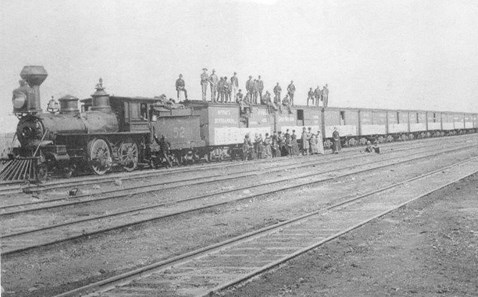These settlers had said “Goodbye” to South Dakota and were on their way westward to Yorkton, which was, at the time, the end of the line of the Manitoba and North Western Railway. Also, a Dominion Lands Office was located here where you could file for homestead lands. They came mainly to file for these free homesteads and so many of these folks settled in the Sheho area. Some of the settlers in this group were: James and John Prouse, Charles Van Dyke, Everett Chapman, Isaac Smith, E. Pettit, Charles Hiltgen, Peter and Sam Wunder, William Haw, James Graneen, John Rendernecht, and William Kittel. They had experienced hard times as South Dakota farmers due to years of drought. Some were Canadians formerly from Ontario.
So, how did these settlers end up coming up to the Yorkton region looking for land? Well, after Canadian Confederation of 1867, the Conservative Government began to organize the “opening” of the West. It sent emissaries to the USA to obtain information on homesteading because much of the lands of the American West were settled. And so, Canadian officials sufficiently impressed with what they learned, copied the American legislation: the Homestead Act of 1862, with only a few differences when they wrote the Canadian DOMINION LANDS ACT in 1872. Obviously, while the officials sojourned in the agricultural territories of northern USA, they did some propaganda to invite farmers to come to Western Canada for free homesteads. They were seasoned famers belonging to the Great Plains region, experienced in the type of farming on lands of various and similar quality to be found in our part of the same Great Plains region — the Canadian North West (Manitoba, Saskatchewan and Alberta). Another excellent advantage: they could easily bring farm and household equipment across the border as attested by this photo. They could also drive their livestock across country. It was a big advantage for a homesteader to be outfitted for pioneering from the start. And government land agents were going to have an easier time in helping these homesteaders to settle. Furthermore, the government was obviously saving on the cost of immigration. When looking to the Commonwealth countries such as England and Scotland, or further afield in Western or Eastern Europe, there was the added travel, having to advertise in various languages, send colonizing agents and interpreters, finance various travel costs of settlers, etc.
Howard Jackson, long time City Clerk and descendant of a Yorkton pioneer from Ontario, writes about these particular settlers in the 1960s. To quote him: “All of these people and names are still known and kindly remembered in the Sheho and Yorkton districts.”
Contact Terri Lefebvre Prince,
Heritage Researcher,
City of Yorkton Archives,
Box 400, 37 Third Avenue North
Yorkton, Sask. S3N 2W3
306-786-1722 [email protected]




